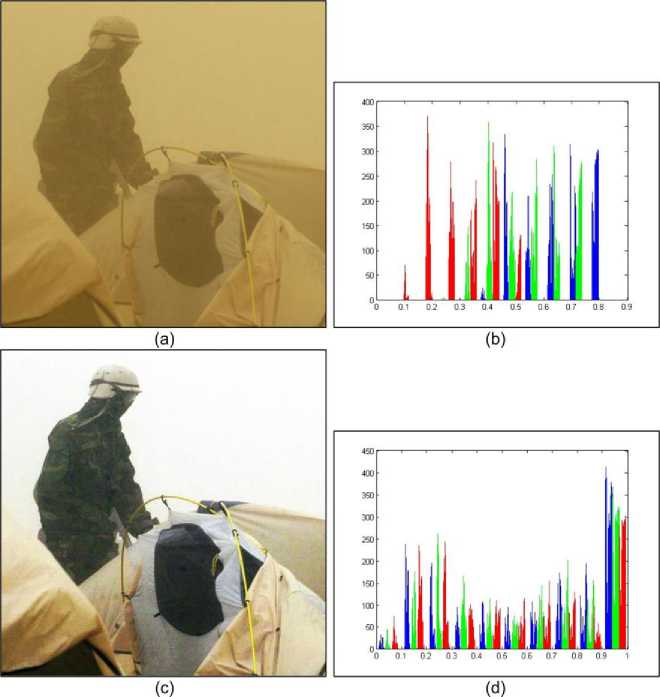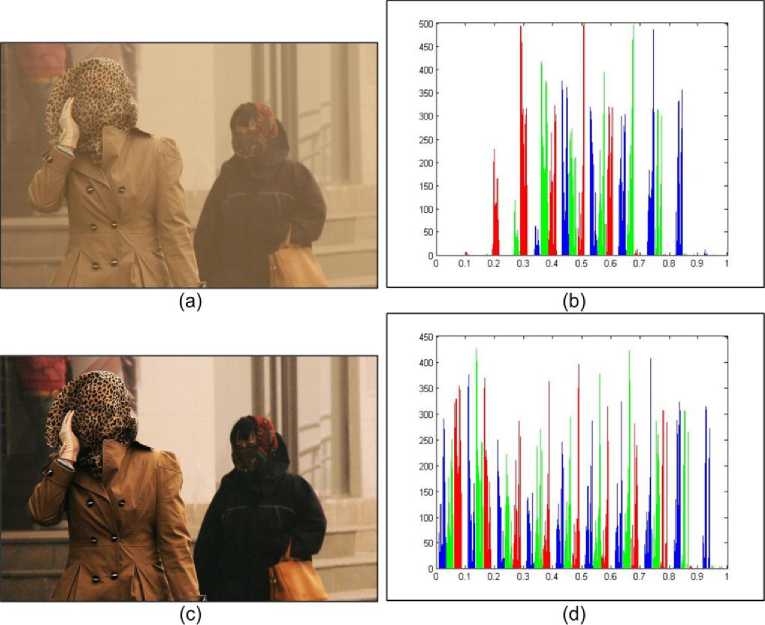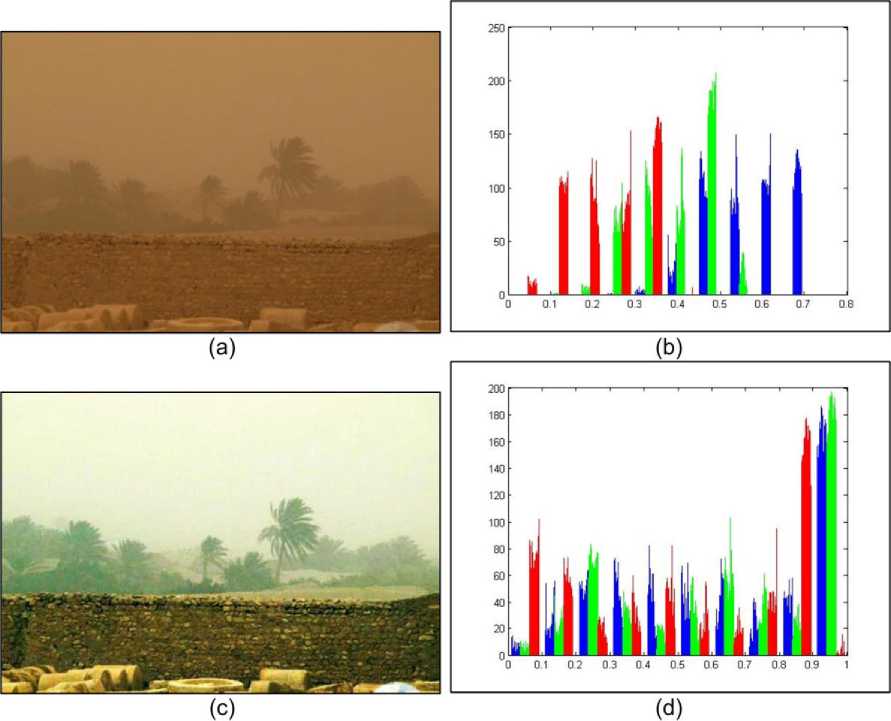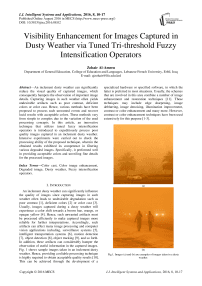Visibility Enhancement for Images Captured in Dusty Weather via Tuned Tri-threshold Fuzzy Intensification Operators
Автор: Zohair Al-Ameen
Журнал: International Journal of Intelligent Systems and Applications(IJISA) @ijisa
Статья в выпуске: 8 vol.8, 2016 года.
Бесплатный доступ
An inclement dusty weather can significantly reduce the visual quality of captured images and this consequently leads to hamper the observation of meaningful image details. Capturing images in such weather often leads to undesirable artifacts such as poor contrast, deficient colors or color cast. Hence, various methods have been proposed to process such unwanted event and recover vivid results with acceptable colors. These methods vary from simple to complex due to the variation of the used processing concepts. In this article, an innovative technique that utilizes tuned fuzzy intensification operators is introduced to expeditiously process poor quality images captured in an inclement dusty weather. Intensive experiments were carried out to check the processing ability of the proposed technique, wherein the obtained results exhibited its competence in filtering various degraded images. Specifically, it performed well in providing acceptable colors and unveiling fine details for the processed images.
Color cast, Color image enhancement, Degraded image, Dusty weather, Fuzzy intensification operators
Короткий адрес: https://sciup.org/15010844
IDR: 15010844
Текст научной статьи Visibility Enhancement for Images Captured in Dusty Weather via Tuned Tri-threshold Fuzzy Intensification Operators
Published Online August 2016 in MECS
An inclement dusty weather can significantly influence the quality of images since capturing images in such weather often leads to undesirable degradation such as poor contrast [1], deficient colors [2] or color cast [3]. Usually, images captured during a dusty weather will experience a color shift towards a brown hue, orange, or opaque yellow [4]. Hence, such unwanted artifacts must be processed efficiently to make captured images more reliable for further interpretations. Accordingly, such artifacts can affect many image processing and computer vision applications including, surveillance systems [5], intelligent transportation systems [6], motion detection [7], object detection [8], object tracking [9], and so forth. In addition, these artifacts can considerably hamper the observation of useful information in the captured images. Fig. 1 shows sample images taken in an inclement dusty weather. Hence, providing a reliable processing technique is highly required to obtain acceptable quality results [10]. This can be achieved through the development of a specialized hardware or specified software, in which the latter is preferred in most situations. Usually, the schemes that are involved in this area combine a number of image enhancement and restoration techniques [11]. These techniques may include edge sharpening, image deblurring, image denoising, illumination improvement, contrast or color enhancement and many more. However, contrast or color enhancement techniques have been used extensively for this purpose [1-3].

(a)

(b)
Fig.1. Images (a) and (b) are examples of images taken in a dusty weather.
The aim of such techniques is to ameliorate the appearance of an image by providing a better visibility with an improved contrast or color fidelity [12]. In recent years, the research in this field increased due to the upsurge of sandstorms and dusty weather conditions. The difficulty of the introduced methods by renowned researchers varies due to the variation of the used processing concepts. In [1], the authors proposed a scheme that utilizes a modified version of a histogram equalization technique in the fuzzy domain, while in [3] the authors introduced an innovative Laplacian based visibility enhancement scheme to efficiently solve the color cast degradation. In addition, the authors of [11] presented a scheme which processes a given image in a CIELAB color space with a local Laplacian filter to correct the poor colors of a corrupted dusty image. In this article, the focus is on improving the color fidelity of images captured in a dusty climate. The aforesaid can be achieved by proposing an innovative technique that utilizes tri-threshold fuzzy intensification operators which are tuned by a novel adjustment method. To test the efficiency of the proposed technique, intensive experiments have been made with various real-world degraded images acquired from different sources and the obtained findings are provided in the forthcoming sections. The rest of this article is organized as follows: in Section II, a concise review about the use of fuzzy intensification operators by other researchers is given. In addition, a detailed clarification about the proposed method is provided in Section III, while in Section IV, the indispensable experimental results and their related discussions are presented. Finally, a brief closure is given in Section V.
-
II. L iterature R eview
In this section, a concise review of literature about the use of fuzzy intensification operators is given. As known, such operators have been studied and utilized by many researchers to solve various problems in the field of digital image processing. Accordingly, the difficulty of the proposed research works varies from simple to complex due to the existence of different real-world problems. However, all these research works share the same goal of retrieving important details while processing degraded images. In [16] the authors used fuzzy intensification operators for the purpose of image enhancement, which is to improve the recognition of grayscale optical characters, while the authors of [17] used a modified version of such operators with an automatic crossover point selection to improve the contrast of digital images. In addition, the authors of [18] employed the aforementioned operators to reduce the computation cost of their algorithm and thus provide a better image segmentation process. Moreover, the authors of [19] applied a Gaussian membership function along with the intensification operators to provide acceptable enhancement of color images. In [20], the authors used the above-mentioned operators to improve the contrast of digital images in the compressed domain, while the authors of [21] employed these operators as a contrast enhancement technique within their method to improve the detection of microcalcifications in mammogram images. In [22], the author utilized these operators to improve the contrast of ultrasound images and facilitate the process of prostate boundaries detection. Furthermore, the authors of [23] used the fuzzy intensification operators to enhance the contrast of digital images captured by a near infrared imaging device for hand veins. Besides, the authors of [24] employed these operators to ameliorate the visual quality of colored images by designing a high performance multicore CPU processing system. As well, the author of [25] used these operators to enhance the contrast of human face images for the purpose of face detection. Finally, developing an inventive technique that utilizes fuzzy intensification operators is necessary, since it has the potential to be applied in many fields of computer vision and digital image processing.
-
III. P roposed T echnique
In this section, the proposed enhancement technique is explained in detail. Accordingly, a concise description for the utilized processing framework is given in Fig. 2. Going into details, the proposed technique starts with the reception of zeta (ζ), which is a tuning parameter that is used to control colors fidelity of the processed image. Then, the degraded image is inputted and disintegrated into its essential channels of Red, Green and Blue (RGB). To calculate the intensification operators, two factors are required. First, the calculation of parameter tau (τ) which represents the thresholding limits of the operators. The use of (τ) helps in processing image pixels by the operators. Second, a membership function is required because it sets the pixels’ values of a given channel to the default range between zero and one. This function must be implemented so that the intensification operators can function well. The membership function for each channel is calculated as follows [13]:
_ [ r - min( r ) ]
R [ max( r ) - min( r ) ]
= [ g - min( g ) ]
G [ max( g ) - min( g ) ]
= [ b - min( b ) ]
B [ max( b ) - min( b ) ]
Where, { f R , f G , f B } represent the output of the membership functions for the Red, Green and Blue channels. { r , g , b} represent the inputted Red, Green and Blue channels. { min , max } represent the minimum and maximum pixel values of the inputted channel. In many image processing applications, fuzzy intensification operators have been used to improve the contrast or color fidelity of a given image [14]. The intensification
operator for each channel is computed as follows [15]:
2*( fR ( x , У ))2, if fR ( x , У ) ^ T R (4)
1 - 2 * (1 - fR (x, y))2, otherwise kG
= s
-
2 * ( f G ( x , У )) 2, if fG ( x , У ) ^ T G
1 - 2*(1 - fG ( x , y ))2, otherwise
k = | 2 * ( f B ( x , У))2 , if fB ( x , У ) ^ T B (6)
B [ 1 - 2*(1 - fB (x, у ))2, otherwise where, {τR, τG, τB} are predetermined scalars with the values of 0.5, 0.6 and 0.4, respectively. {kR, kG, kB} represent the processed channels by intensification operators. {x, y} are spatial coordinates. {fR(x,y), fG(x,y), fb(x,y)} are pixels of the inputted RGB channels.
Once these operators are applied, the obtained result of each channel is then tuned using the proposed tuning method, which can be expressed as:
Ur = (kR )TR +f(7)
Ug = (kG )TG +Z(8)
Ub = (кв )TB +Z(9)
Thereafter, the tuned outputs { uR , uG , uB } are concatenated to form the colored image which represents the final output of the proposed technique. In image processing context, concatenation is the process of linking colored channels together in such a way that the output is a single colored image. The concatenation process is achieved using a { cat } function in MATLAB. The proposed technique was implemented with a 2.3 GHz core i5 processor and an 8 GB of memory. As a summary, refer to the subsequent framework for a visual illustration about the proposed processing technique.
Input: tuning parameter
Input: A dusty image
Disintegrate the inputted image to into its RGB layers
Blue layer (B)
Red layer (Ri-

Compute the membership function
Green layer (G)
Set: Tg = 0.6
Compute the membership fiuiction
Set: Tn 0.4
Compute the membership function
Apply the intensification operators
Apply the intensification operators
Apply the intensification operators
Tune the intensification outcome
Tune the intensification outcome
Time the intensification outcome

Fig.2. Framework of the proposed visibility enhancement technique.
-
IV. R esults and D iscussion
In this section, the results, discussions and preparations of computer experiments are reported. The proposed technique was evaluated using a dataset of naturally degraded color images of different scenes captured in an inclement dusty weather. The dataset images were collected from different sources across the internet. For assessment purposes, it is recommended to use a neutral and specialized appraisal method in order to evaluate the extent of enhancement for the processed images. Thus, various well-known appraisal methods were studied to evaluate the accuracy, color fidelity and contrast of dusty images. However, none of these methods delivered meaningful results with the naturally degraded images, in that they delivered unreasoned outputs that do not match with the real observed images. Therefore, the histograms for each of the degraded and the enhanced images were provided to show the achieved enhancement using the proposed technique. Accordingly, visual inspections remain the best method to measure the extent of enhancement in color images. The proposed technique was tested with different real-world degraded images and some results of such are exhibited in Fig. 3 through Fig 8.
From the acquired experimental results, it can be seen that the proposed technique performed well in terms of colors recovery and visual quality, as these aspects improved tremendously compared to the original observations. By comparing the histograms of the original and the processed images, it can be seen that there is a vast difference in terms of colors distribution. The histograms of the original images show an unsound distribution, in which the colors are limited in a certain range. Such unusual distribution indicates that the visual quality of these images is severely degraded. However, the histograms of the processed images show a noteworthy improvement in the allocation of colors, in which they become well distributed to the entire range. This is significant because it indicates that the recovered images have better color quality. Hence, such satisfactory results are expedient for use with different real-life image processing applications. Developing an expedite method that efficiently recover vivid results and unveil improved image details with acceptable colors is critical. Such a chore is clearly accomplished, in which the exhibited results are clearer and thus provide more details than their original counterparts.

Fig.3. Experimental results of the proposed visibility enhancement technique. (a) Naturally degraded dusty image; (b) Histogram of image (a); (c) Recovered image using the proposed technique with ζ = 0.5; (d) Histogram of image (c).

Fig.4. Experimental results of the proposed visibility enhancement technique. (a) Naturally degraded dusty image; (b) Histogram of image (a); (c) Recovered image using the proposed technique with ζ = 0.3; (d) Histogram of image (c).

Fig.5. Experimental results of the proposed visibility enhancement technique. (a) Naturally degraded dusty image; (b) Histogram of image (a); (c) Recovered image using the proposed technique with ζ = 0.4; (d) Histogram of image (c).

Fig.6. Experimental results of the proposed visibility enhancement technique. (a) Naturally degraded dusty image; (b) Histogram of image (a); (c) Recovered image using the proposed technique with ζ = 0.5; (d) Histogram of image (c).

Fig.7. Experimental results of the proposed visibility enhancement technique. (a) Naturally degraded dusty image; (b) Histogram of image (a); (c) Recovered image using the proposed technique with ζ = 0.6; (d) Histogram of image (c).

Fig.8. Experimental results of the proposed visibility enhancement technique. (a) Naturally degraded dusty image; (b) Histogram of image (a); (c) Recovered image using the proposed technique with ζ = 0.7; (d) Histogram of image (c).
-
V. C onclusion
An innovative fuzzy based visibility processing technique is introduced in this article to improve the visual quality of degraded images captured during an inclement dusty weather. The proposed technique utilizes a simple membership function that sets the pixels’ values of a given channel to the range between zero and one, fuzzy intensification operators that are applied depending on different thresholds and a novel adjustment method, which is designed specifically for this technique. The aforesaid procedures are applied to each color channel of the processed image. Experimental results showed that the proposed technique provided vivid results with refined colors and lucid features. This deduction came through performing visual comparisons between the original images and their processed counterparts as well as by construing the provided histograms for each image. Finally, it is believed that this technique can be extended to process other degraded images taken in hazy, foggy or misty weather conditions.
A cknowledgment
The author would like to thank the esteemed editorial committee and reviewers for their constructive comments.
Список литературы Visibility Enhancement for Images Captured in Dusty Weather via Tuned Tri-threshold Fuzzy Intensification Operators
- T. Yan, L. Wang and J. Wang, "Method to Enhance Degraded Image in Dust Environment", Journal of Software, vol. 9, no. 10, pp. 2672- 2677, 2014.
- S. Narasimhan and S. Nayar, "Contrast restoration of weather degraded images", IEEE Transactions on Pattern Analysis and Machine Intelligence, vol. 25, no. 6, pp. 713-724, 2003.
- S. Huang, J. Ye and B. Chen, "An Advanced Single-Image Visibility Restoration Algorithm for Real-World Hazy Scenes", IEEE Transactions on Industrial Electronics, vol. 62, no. 5, pp. 2962-2972, 2015.
- B. Chen and S. Huang, "An Advanced Visibility Restoration Algorithm for Single Hazy Images", ACM Transactions on Multimedia Computing, Communications, and Applications, vol. 11, no. 4, pp. 1-21, 2015.
- S. Huang, "An Advanced Motion Detection Algorithm With Video Quality Analysis for Video Surveillance Systems", IEEE Transactions on Circuits and Systems for Video Technology, vol. 21, no. 1, pp. 1-14, 2011.
- S. C. Huang, B. H. Chen, and Y. J. Cheng, “An efficient visibility enhancement algorithm for road scenes captured by intelligent transportation systems,” IEEE Transactions on Intelligent Transportation Systems, vol. 15, no. 5, pp. 2321–2332, 2014.
- S. C. Huang and B. H. Do, “Radial basis function based neural network for motion detection in dynamic scenes,” IEEE Transactions on Cybernetics, vol. 44, no. 1, pp. 114–125, 2014.
- M. Chacon and S. Gonzalez, “An adaptive neural-fuzzy approach for object detection in dynamic backgrounds for surveillance systems,” IEEE Transactions on Industrial Electronics, vol. 59, no. 8, pp. 3286–3298, 2012.
- X. Zhang, W. Hu, S. Chen, and S. Maybank, “Graph-embedding-based learning for robust object tracking,” IEEE Transactions on Industrial Electronics, vol. 61, no. 2, pp. 1072–1084, 2014.
- K. Kaur and N. Gupta, "Performance Evaluation of Modified DBLA Using Dark Channel Prior & CLAHE", International Journal of Intelligent Systems and Applications, vol. 7, no. 5, pp. 48-56, 2015.
- J. Wang, Y. Pang, Y. He, and Changshu Liu. "Enhancement for Dust-Sand Storm Images." In Lecture Notes in Computer Science (MultiMedia Modeling), Vol. 9516, Q. Tian, N. Sebe, G. Qi, B. Huet, R. Hong and X. Liu, Eds. Springer International Publishing, 2016, pp. 842-849.
- A. Mohamad, "A New Image Contrast Enhancement in Fuzzy Property Domain Plane for a True Color Images", International Journal of Signal Processing Systems, vol. 4, no. 1, 45-50, 2016.
- A. Łoza, D. Bull, P. Hill and A. Achim, "Automatic contrast enhancement of low-light images based on local statistics of wavelet coefficients", Digital Signal Processing, vol. 23, no. 6, pp. 1856-1866, 2013.
- M. Hanmandlu and D. Jha, "An Optimal Fuzzy System for Color Image Enhancement", IEEE Transactions on Image Processing, vol. 15, no. 10, pp. 2956-2966, 2006.
- T. Chaira, and A. Ray, Fuzzy image processing and applications with MATLAB, Boca Raton: CRC Press, 2009, pp. 49-50.
- S. Lam, A. Girardin and S. Srihari, “Gray-scale character recognition using boundary features”, Proceedings of SPIE 1661, Machine Vision Applications in Character Recognition and Industrial Inspection, vol. 98, February 09, 1992, San Jose, USA, pp. 98-105.
- N. Fang and M. Cheng, "An automatic crossover point selection technique for image enhancement using fuzzy sets", Pattern Recognition Letters, vol. 14, no. 5, pp. 397-406, 1993.
- W. Lei and Q. Feihu, "Adaptive fuzzy Kohonen clustering network for image segmentation", International Joint Conference on Neural Networks, vol. 4, 10 Jul 1999-16 Jul 1999, Washington, USA, pp. 2664-2667.
- M. Hanmandlu, D. Jha and R. Sharma, "Color image enhancement by fuzzy intensification", Pattern Recognition Letters, vol. 24, no. 1-3, pp. 81-87, 2003.
- C. Florea, A. Vlaicu, M. Gordan and B. Orza, "Fuzzy intensification operator based contrast enhancement in the compressed domain", Applied Soft Computing, vol. 9, no. 3, pp. 1139-1148, 2009.
- F. Sahba and A. Venetsanopoulos, "A novel fuzzy based framework for detection of clustered microcalcification in mammograms", IEEE International Conference on Fuzzy Systems, 18-23 July 2010, Barcelona, Spain, pp. 1-6.
- F. Sahba. “A new method for contour determination of the prostate in ultrasound images.” In Abdominal Imaging. Computational and Clinical Applications, H. Yoshida, G. Sakas and M. Linguraru, Eds. Springer Berlin Heidelberg, 2011, pp. 248-255.
- M. Yakno, J. Saleh and B. Rosdi. “Low contrast hand vein image enhancement”, IEEE International Conference on Signal and Image Processing Applications, 16-18 Nov. 2011, Kuala Lumpur, Malaysia, pp. 390-392.
- A. Kamalakannan and G. Rajamanickam, "High Performance Color Image Processing in Multicore CPU using MFC Multithreading", International Journal of Advanced Computer Science and Applications, vol. 4, no. 12, pp. 42-47, 2013.
- G. Sudhavani, K. Ram, P. Rao and K. Prasad, "Face Detection and Tracking in Fuzzy Enhanced Low Contrast Images", International Journal of Computer Applications, vol. 119, no. 16, pp. 31-35, 2015.


